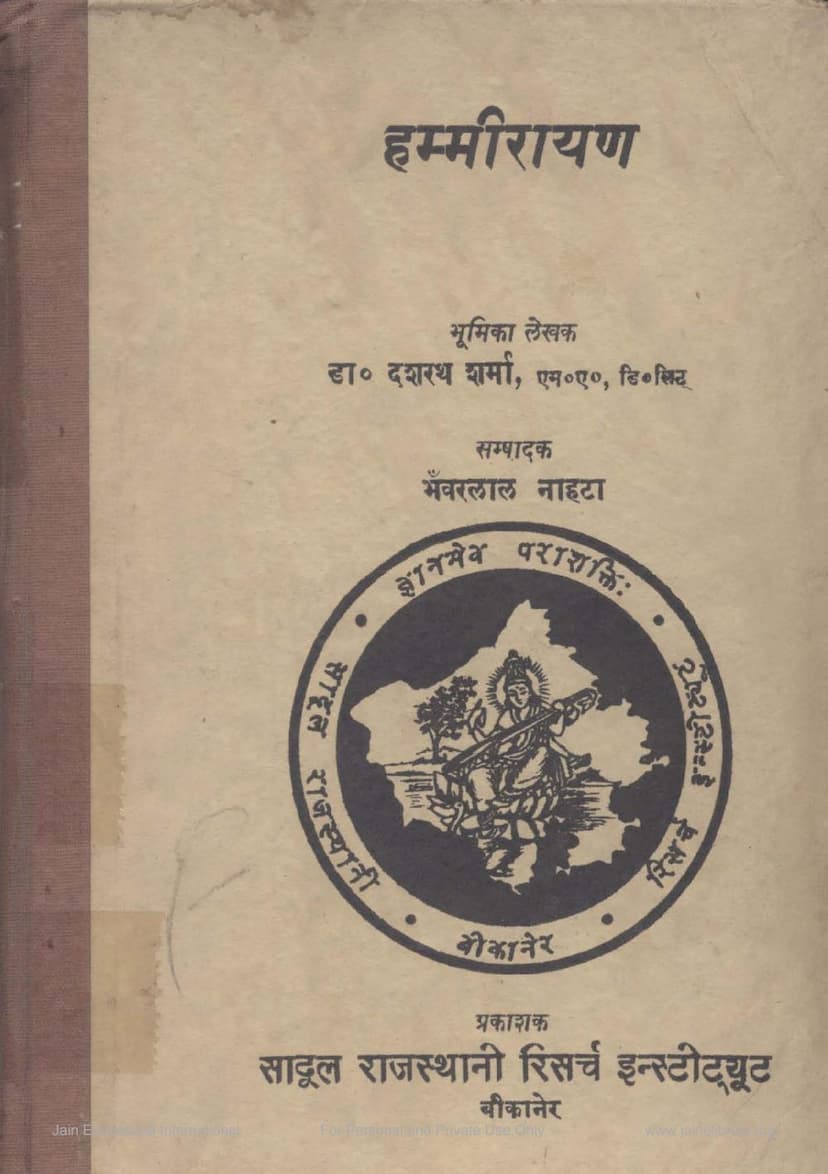Hammirayan
Added to library: September 1, 2025

Summary
This is a comprehensive summary of the provided Jain text, "Hammirayan," authored by Bhanvarlal Nahta and published by Sadul Rajasthani Research Institute, Bikaner.
Book Title: Hammirayan Author: Bhanvarlal Nahta (Editor) Publisher: Sadul Rajasthani Research Institute, Bikaner Foreword by: Dr. Dashrath Sharma
Overview:
"Hammirayan" is a significant work in Rajasthani literature, focusing on the valorous deeds and tragic end of Hammirdev Chauhan, the ruler of Ranthambore. The book is presented as a critical edition, edited by Bhanvarlal Nahta, with a detailed foreword by Dr. Dashrath Sharma, a renowned historian and scholar. The Sadul Rajasthani Research Institute, Bikaner, is dedicated to the service and development of Sanskrit, Hindi, and especially Rajasthani literature. This publication is part of their extensive efforts to preserve and promote ancient Rajasthani literary heritage.
Key Content and Themes:
- The Hammirayan Epic: The core of the book is the "Hammirayan," a 14th-century Jain composition by Bhandau Vyas, detailing the life and battles of Hammirdev Chauhan. It is presented in its original Rajasthani verse, with extensive commentary and analysis.
- Historical Context: Dr. Dashrath Sharma's foreword provides a deep dive into the historical context of Hammirdev Chauhan, the political landscape of Rajasthan during his era, and the various historical and literary sources available on Hammir. He critically examines the authenticity and significance of different accounts, comparing "Hammirayan" with other contemporary works like "Hammir Mahakavya" by Jainacharya Nayachandra Suri, "Hammir Raso" by Jodhraj, and even Muslim chronicles.
- Literary Analysis: The foreword extensively analyzes the language, style, and narrative structure of "Hammirayan." It discusses the poet Bhandau Vyas, his background, and his family lineage, also addressing some scholarly debates regarding the poet's identity and the interpretation of certain verses.
- Hammir's Character: The book portrays Hammirdev Chauhan as a symbol of Rajput valor, pride, and unwavering commitment to his word and to protecting those who seek his refuge. His defiance against the powerful Sultan Alauddin is highlighted as a testament to his courage. His adherence to dharma and honor, even in the face of overwhelming odds, is a central theme.
- The Conflict with Alauddin: The narrative vividly describes the prolonged siege of Ranthambore by Alauddin's forces, the strategic maneuvers, the bravery of Hammir and his commanders, and the eventual betrayal from within the fort. The story culminates in the heroic Jauhar (mass self-immolation) of the women and the final stand and self-sacrifice of Hammir and his remaining warriors.
- Patronage and Publication Efforts: The introductory pages detail the mission and achievements of the Sadul Rajasthani Research Institute. It lists various projects undertaken, including the compilation of a comprehensive Rajasthani-Hindi dictionary, a dictionary of Rajasthani idioms, and the publication of modern Rajasthani works. The institute's dedication to researching, editing, and publishing ancient Rajasthani texts is emphasized, acknowledging the financial challenges they face and the grants received from the government.
- Comparative Study: A significant portion of the foreword is dedicated to a comparative analysis of "Hammirayan" with other literary and historical accounts of Hammir's life. This comparison highlights similarities and differences in narratives, character portrayals, and historical details, providing valuable insights for researchers.
- Linguistic and Cultural Insights: The text offers glimpses into the social and military life of 14th-century Rajasthan, including descriptions of forts, warfare, the role of patrons (samantas) and merchants (mahajans), and the cultural practices of the time. The language used provides valuable linguistic data for the study of Old Rajasthani.
- Appendices: The book includes extensive appendices featuring verses from "Prakrit Paingalam" related to Hammir, verses from "Kavitta" by Bhat Khem, the "Dayavir Katha" from Vidyapati's "Purush Pariksha," and various other related compositions. These appendices enrich the scholarly value of the edition by providing source material for further study.
- Corrigenda: A detailed "Shuddha-Ashuddha Patra" (Errata) is provided, indicating corrections for printing errors, demonstrating the rigorous editorial process.
Significance of "Hammirayan":
- Preservation of Heritage: It represents a vital effort to preserve an important piece of Rajasthani literary and historical heritage.
- Scholarly Value: The critical edition, coupled with Dr. Dashrath Sharma's extensive and well-researched foreword, makes it an invaluable resource for scholars of Rajasthani literature, history, and Jain studies.
- Literary Merit: The epic itself, though ancient, is recognized for its narrative power and its depiction of heroic ideals, offering insights into medieval Indian bardic traditions.
- Understanding Hammir's Legacy: The text contributes to understanding the enduring legacy of Hammirdev Chauhan as an epitome of Rajput valor and defiance, a figure celebrated in folk memory and literature.
In essence, "Hammirayan," as presented by the Sadul Rajasthani Research Institute and critically examined by Dr. Dashrath Sharma, is a scholarly endeavor to bring a significant historical and literary epic to a wider audience, providing a deep understanding of Hammirdev Chauhan's life, times, and the rich cultural heritage of Rajasthan.